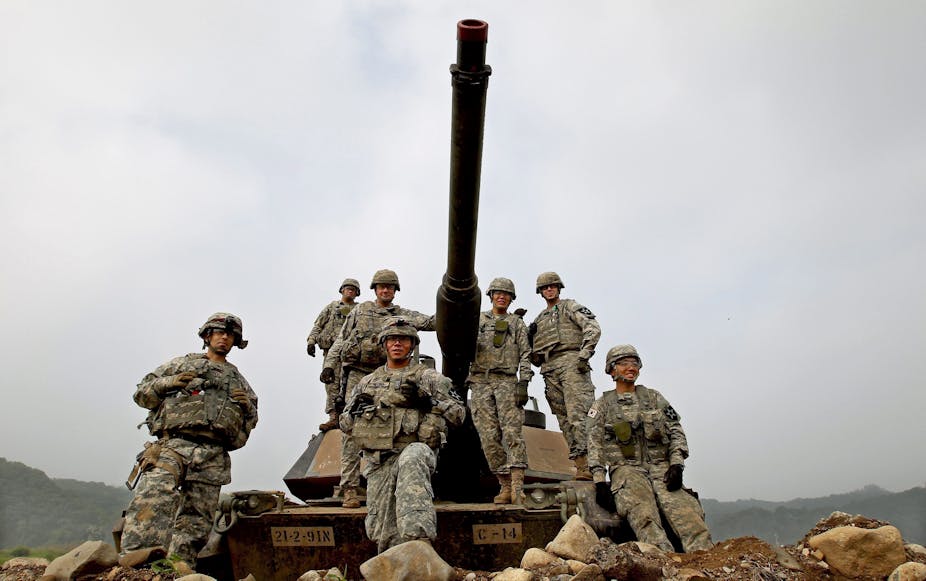When introducing the Pentagon’s US$496 billion budget last week – $31 billion below what President Barack Obama requested – US Defence Secretary Chuck Hagel said:
We are repositioning to focus on the strategic challenges and opportunities that will define our future in a world that is growing more volatile, more unpredictable and in some instances more threatening to the United States.
Once the most powerful economy in the world with no real challenge to its global dominance, the US is facing real threats. At home, the US faces a wide range of domestic problems and serious economic challenges. These are partly the consequences of a staggering US$318 billion trade deficit with China in 2013.
The China challenge
Internationally, decades of political, military and economic foreign interventions to serve – first and foremost – America’s “national interest” have undermined US credibility. These range from the Middle East, where it has fought two decades of unsuccessful wars, to South and Central America, Africa and South-East Asia.
Now, the US faces the emergence of China as a world economic powerhouse and a significant threat to its hegemony.
It is hardly a surprise that the US is desperate to revitalise its Asia-Pacific hegemony to compensate for its declining power. To achieve this goal, the Obama administration is weaving together a web of military and political alliances and relationships. This ranges from Japan to India, across Central and East Asia, from north-west Pacific to New Zealand.
Using well-defined defence diplomacy initiatives, the US is attempting to leverage its allies’ resources and power while taking advantage of regional insecurities. These are a result of China’s rising power and determination to protect its maritime access.
The success of the Asia-Pacific “rebalancing” depends on America’s ability to build relationships across the region in the context of China’s growing economy, expanding influence and accelerating military capabilities. This highlights the importance to the Asia-Pacific rebalance of forward presence. This is to be achieved by integrating US forces with partner countries across the region and building new alliances.
While China is dotting the region with strategic investments, the Obama administration is focusing obsessively on building its military power. The US is dotting the region with new bases and other means of containment.
New bases
The number of large US bases is declining, together with the number of military personnel. However, the global infrastructure of small overseas bases is multiplying rapidly. Over time, this increase could give Pentagon strategists the flexibility to react quickly to developments anywhere, approaching outright military superiority.
The US military-led humanitarian intervention in the Philippines following Typhoon Haiyan last November shows how effective this strategy can be. Within days of the crisis, the US had mounted a significant military intervention. Forces converged on the Philippines from various locations across the region.
The multiplicity of small bases also allows strategists to factor in changes in political circumstances in any specific country. Should the US be prevented from using facilities, they can turn to another nearby. This happened with Turkey in 2003.
Small bases are less likely to be opposed by local populations, as happened in the Philippines and Japan. Finally, the mobility of the US forces would make it harder for China to fight should a conflict emerge.
In this way, the Pentagon is developing small and flexible Forward Operating Sites, and even smaller Cooperative Security Locations, nicknamed “lily pads”, all around the world. These are small, secretive, hard-to-reach facilities with limited numbers of military specialists, minimal amenities and prepositioned weaponry and supplies. There are plans to build advance command posts on Palawan near the Spratly Islands to monitor the South China Sea.
Ensuring sustainability is essential to the success of any forward strategy and depends on Main Operating Bases, often located on allies’ territory. US partners in the region include Japan, South Korea, Australia, the Philippines, Singapore and Thailand. These countries have allowed the US comprehensive access to facilities and assets.
In an effort to secure the control of maritime routes, as well as access to a wider range of strategic locations, the US is negotiating with other states including Indonesia, New Zealand and an old wartime foe: Vietnam.

Geostrategic ‘rebalancing’
In yet another sign that pragmatism and national interest can easily bring collaboration with despotic and corrupt regimes – and take precedence over human rights, democracy and socioeconomic needs – the Obama administration has already called for congressional support for “non-lethal military assistance to the Myanmar military”.
This came despite widespread evidence of sectarian violence and human rights abuses. Myanmar’s location between the Pacific and Indian oceans, bordering China and India, is critical to the US geostrategy. Standing near Obama at the Pentagon in January 2012, General Martin Dempsey, chairman of the Joint Chiefs of Staff, said:
… our strategic challenges will largely emanate out of the Pacific region, but also the littorals of the Indian Ocean.
Washington’s Asia-Pacific geostrategic rebalancing aims to bind countries in the region as closely as possible to the US military and thereby protect the political and economic hegemony of the US. The various forms of power projection are also political and economic tools to build and maintain alliances and provide privileged US access to overseas markets, resources and investment opportunities.
China is the largest trading partner for many nations in the region, and revenue from trade with China is a significant element of their GDP. As China grows, however, insecurities are building. That makes the US rebalancing with its strong military foundation timely.
For the region, there is a growing dilemma posed by the tensions between trade benefits with China and security imperatives with the US.

